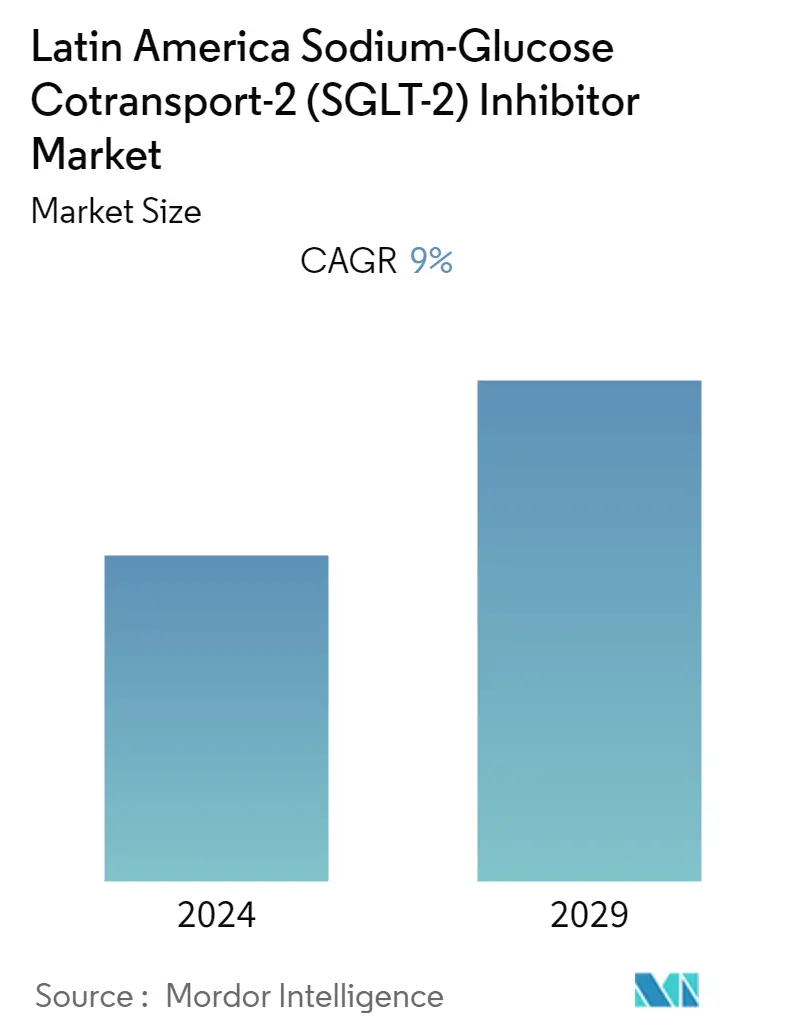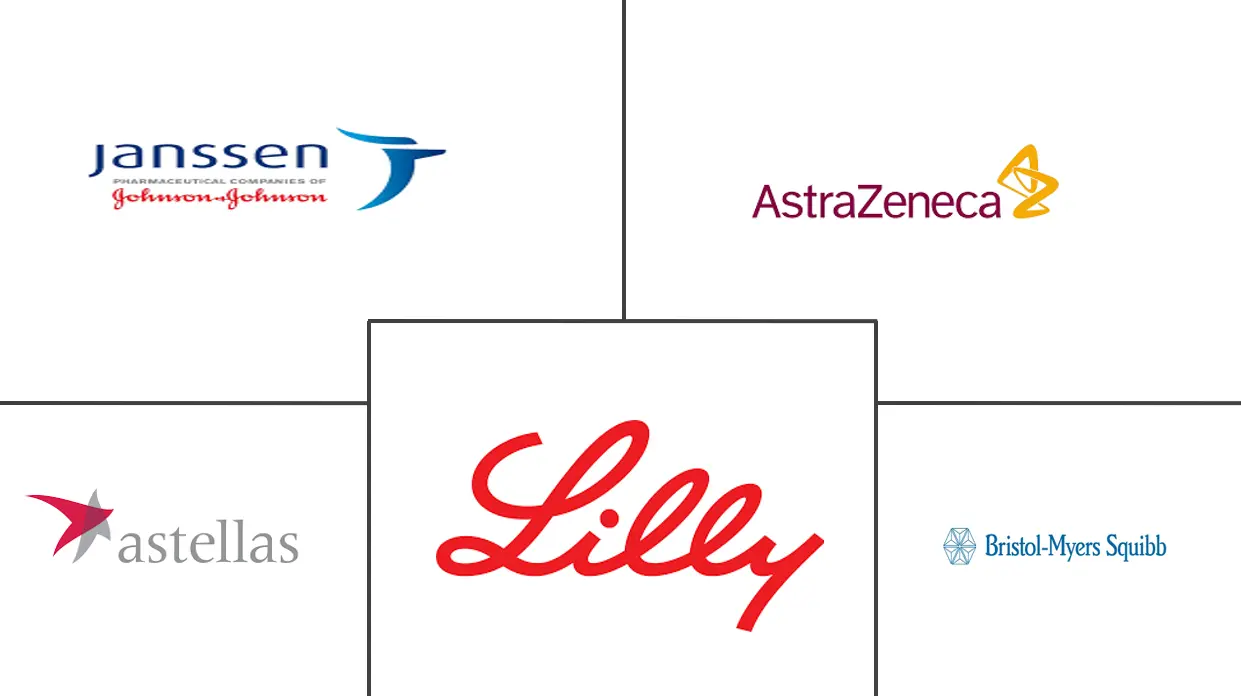Market Size of Latin America Sodium-Glucose Cotransport-2 (SGLT-2) Inhibitor Industry

| Study Period | 2019 - 2029 |
| Base Year For Estimation | 2023 |
| Forecast Data Period | 2024 - 2029 |
| Historical Data Period | 2019 - 2022 |
| CAGR | 9.00 % |
Major Players
*Disclaimer: Major Players sorted in no particular order |
Latin America Sodium-Glucose Cotransport-2 Inhibitor Market Analysis
The Latin America Sodium-Glucose Cotransport-2 (SGLT-2) Inhibitor Market size is estimated at USD 0.3 billion in current year, and is expected to reach USD 0.5 billion by forecast period, growing at a CAGR of 9% during the forecast period.
The COVID-19 pandemic has been testing the capacity to respond and adapt to populations, governments, and health systems worldwide. In the Latin America region, Brazil presented the first suspected and the first confirmed cases. Most Latin American countries failed to implement timely measures to protect individuals with diabetes, which may severely impact individuals, health systems, and economies.
The diabetic prevalence is high in countries in the Latin American region, and Mexico is known to have a high number of diabetic patients due to the growing prevalence of Type-2 diabetes in the country. The gradually growing obesity rate, combined with the genetic predisposition for Type-2 diabetes, is acted as a prominent driver for the increase in the Type-2 diabetic population over the last 40 years. Currently, close to 10% of the total population is living with diabetes. Diabetic patients in the Latin American region mainly suffer from Type-2 diabetes, and they accounted for close to 90% of the total diabetic population in 2021.
The COVID-19 pandemic benefited the Sodium-Dependent Glucose Cotransporter 2 market. Diabetes weakens the immune system, which is exacerbated by COVID-19. Diabetes patients are more likely to have significant problems than non-diabetics. During COVID-19, diabetic medicine manufacturers took care to ensure that pharmaceuticals were delivered to diabetes patients with the assistance of local governments. Novo Nordisk stated that Since the outbreak of COVID-19, their commitment to patients, staff and the communities in which they operate has not changed, and they will continue provide their medicines and devices to people with diabetes and other serious chronic conditions, protect the health of their employees, and support doctors and caregivers in the fight against COVID-19 in Latin America.
Latin America Sodium-Glucose Cotransport-2 Inhibitor Industry Segmentation
With diet and exercise, SGLT2 inhibitors are a family of prescription drugs that the FDA has licensed for use in persons with type 2 diabetes to reduce blood sugar levels. The Latin America Sodium-Glucose Cotransport-2 (SGLT-2) Inhibitor Market is segmented by Drug (Invokana, Jardiance, Farxiga/Forxiga, and Suglat) and by Geography (Brazil, Mexico, Rest of Latin America). The report offers the value (in USD) and Volume (in Units) for the above segments.
| Drug | |
| Invokana (Canagliflozin) | |
| Jardiance (Empagliflozin) | |
| Farxiga/Forxiga (Dapagliflozin) | |
| Suglat (Ipragliflozin) |
| Geography | |
| Brazil | |
| Mexico | |
| Rest of latin America |
Latin America Sodium-Glucose Cotransport-2 (SGLT-2) Inhibitor Market Size Summary
The Latin America Sodium-Glucose Cotransport-2 (SGLT-2) Inhibitor Market is poised for significant growth, driven by the high prevalence of Type-2 diabetes in the region, particularly in Mexico. The market is characterized by the increasing adoption of SGLT-2 inhibitors, also known as gliflozins, which are crucial in managing blood glucose levels and cardiovascular risk factors. The COVID-19 pandemic has underscored the importance of these medications, as diabetes patients faced heightened health risks, prompting manufacturers to ensure continued access to essential medications. The market landscape is further shaped by technological advancements and regulatory approvals, which have expanded the therapeutic applications of SGLT-2 inhibitors.
Mexico stands out as a dominant player in the Latin American SGLT-2 inhibitor market, accounting for a substantial share due to its high diabetic population. The Mexican healthcare system, supported by both public and private sectors, facilitates access to diabetes care, although challenges remain in terms of late diagnosis and limited treatment availability. The market is highly consolidated, with major global manufacturers like AstraZeneca, Eli Lilly, and Bristol Myers Squibb playing pivotal roles. These companies are enhancing their market presence through strategic approvals and product innovations, aiming to address the growing demand for effective diabetes management solutions in the region.
Latin America Sodium-Glucose Cotransport-2 (SGLT-2) Inhibitor Market Size - Table of Contents
-
1. MARKET DYNAMICS
-
1.1 Market Overview
-
1.2 Drivers
-
1.3 Restraints
-
1.4 Porter's Five Forces Analysis
-
1.4.1 Bargaining Power of Suppliers
-
1.4.2 Bargaining Power of Consumers
-
1.4.3 Threat of New Entrants
-
1.4.4 Threat of Substitute Products and Services
-
1.4.5 Intensity of Competitive Rivalry
-
-
-
2. Market Segmentation
-
2.1 Drug
-
2.1.1 Invokana (Canagliflozin)
-
2.1.2 Jardiance (Empagliflozin)
-
2.1.3 Farxiga/Forxiga (Dapagliflozin)
-
2.1.4 Suglat (Ipragliflozin)
-
-
2.2 Geography
-
2.2.1 Brazil
-
2.2.2 Mexico
-
2.2.3 Rest of latin America
-
-
Latin America Sodium-Glucose Cotransport-2 (SGLT-2) Inhibitor Market Size FAQs
What is the current Latin America Sodium-Glucose Cotransport-2 (SGLT-2) Inhibitor Market size?
The Latin America Sodium-Glucose Cotransport-2 (SGLT-2) Inhibitor Market is projected to register a CAGR of 9% during the forecast period (2024-2029)
Who are the key players in Latin America Sodium-Glucose Cotransport-2 (SGLT-2) Inhibitor Market?
Astrazeneca, Eli Lilly, Astellas, Bristol Myers Squibb and Janssen are the major companies operating in the Latin America Sodium-Glucose Cotransport-2 (SGLT-2) Inhibitor Market.

